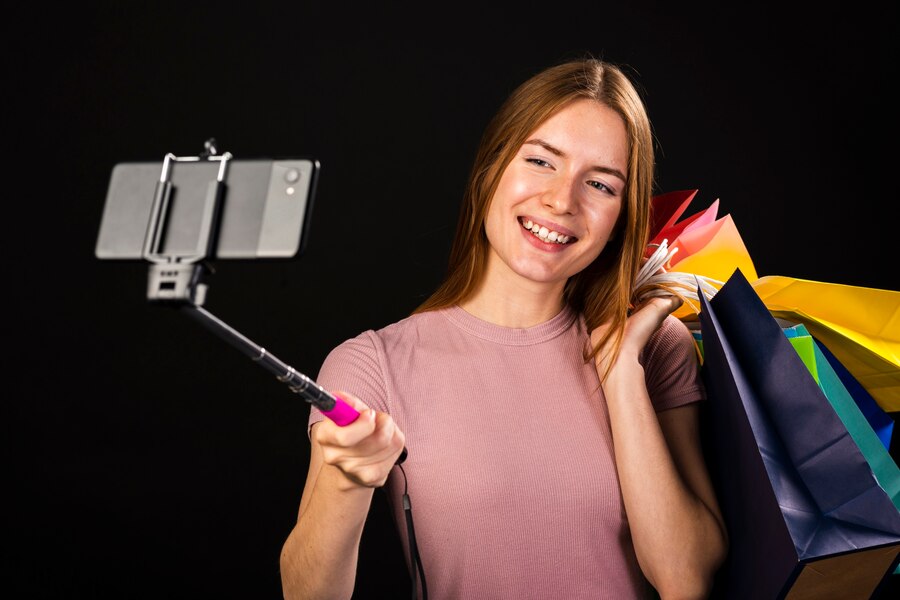Influencer marketing has emerged as a key marketing channel for ecommerce brands due to its impressive ROI, high influencer engagement rates, and strategic targeting of online audiences. Brands can effectively reach their goals using influencer marketing by leveraging the trustworthiness of influencers through sponsored endorsements.
In fact, it’s proved to be one of the most fruitful marketing initiatives for ecommerce brands of all sizes. Lately, many e-commerce businesses have achieved tremendous success by partnering with top influencers as part of their social media marketing strategies.
This marketing strategy essentially uses authentic recommendations from social media influencers to persuade individuals to try out a new brand, eventually converting them into returning customers. In this blog post, we will learn more about influencer marketing.
Why Is Influencer Marketing Important?
Influencer marketing has proven extremely crucial in today’s digital age. It provides a more genuine and personal experience compared to traditional advertisements as it capitalizes on established influencers’ existing follower base and engagement rates. Ecommerce brands can effectively harness the power of personable content that adds value to followers, prompting higher engagement rates than typical corporate-style account posts.
According to a RivalIQ study, influencers had a higher engagement rate on Instagram when compared to brand accounts related to specific verticals such as fashion, beauty, home decor, alcohol, and retail. This clearly highlights the potency of influencers in creating awareness and boosting sales for ecommerce sites amongst new online target audiences on social networks.
Hence, integrating influencer partnerships into broader marketing initiatives can significantly augment your outreach and recognition.
What Are The Top Social Media Channels for Ecommerce Influencer Marketing?
Choosing the right social media platform is essential for successful influencer marketing. While platforms like Instagram, YouTube, Facebook, and Pinterest are powerful marketing tools, each boasts unique features, making them suitable for different influencer campaigns. Let’s discuss this further in the following section.
1. Instagram
Instagram remains one of the most popular platforms for ecommerce influencer marketing due to its visual-centric format and high user engagement rate. With features such as Stories, Reels, and Shopping, Instagram provides a seamless blend of commerce and content marketing.
Refer to the table below to better understand its features:
|
Instagram Influencer Marketing Strategy |
Description |
|
Stories |
Short, fun, and easy to consume, Instagram Stories can be used by influencers to introduce new products, showcase unboxing, convey limited-time offers, and even link to product pages using the ‘Swipe Up’ feature. |
|
Reels |
A relatively newer addition to Instagram, Reels can be leveraged by influencers to create engaging, short video content showcasing product usage in aesthetically pleasing and creative ways. It’s a great way to capture the user’s attention and drive them toward your products. |
|
Shopping |
Instagram Shopping, combined with influencers, provides a seamless, shopable experience. Influencers can tag your products in their posts, allowing followers to click on these tags and purchase products directly from the Instagram app. |
2. YouTube
YouTube is another powerful channel for ecommerce influencer marketing due to its extensive reach and video-format content. It allows influencers to create comprehensive product reviews, tutorials, and unboxing videos, providing potential customers with a deeper understanding of your product.
Refer to the table below to better understand its features:
|
YouTube Influencer Marketing Strategy |
Description |
|
Product Reviews |
Influencers can post detailed review videos of your product, showcasing its features and uses, while offering their honest opinion. |
|
Tutorials |
For more complex products, influencers can create tutorial or ‘How-To’ videos, demonstrating how to use your product effectively. |
|
Unboxing Videos |
A popular format on YouTube, influencers can include your product in their ‘unboxing’ videos, creating excitement and anticipation among viewers. |
3. Facebook
While often underrated, Facebook is a potent platform for influencer marketing. With its broad user base and diverse demographics, it can be an ideal platform for reaching a wide range of audiences.
Refer to the table below to better understand its features:
|
Facebook Influencer Marketing Strategy |
Description |
|
Live Streams |
Influencers can conduct Facebook Live streams showcasing and discussing your product in real-time, engaging thoroughly with the viewers. |
|
Posts and Stories |
Similar to Instagram, Facebook also offers Stories where influencers can share posts about your product. They can also post detailed descriptions, product photos, and reviews on their timeline. |
4. Pinterest
Pinterest is an under-utilized resource for influencer marketing, especially for niche categories like DIY, home decor, fashion, and food. The platform’s visually oriented design is ideal for showcasing products in aesthetically appealing ways.
Refer to the table below to better understand its features:
|
Pinterest Influencer Marketing Strategy |
Description |
|
Pins |
Influencers can create attractive Pins featuring your products, which can then be saved or ‘repinned’ by users to their own boards, increasing your product’s visibility. |
|
Product Reviews |
Influencers can also write detailed product reviews attached to Pins, providing additional information and opinions about your product. |
How to Build a Strong Influencer Marketing Strategy?
Strategizing your influencer marketing campaign is crucial for effective execution. While it might seem a lengthier process, executing it step-by-step can help! The following section will give several ideas for building a solid influencer marketing strategy.
1. Conducting effective influencer outreach
Influencer outreach is the first step in influencer marketing, requiring targeted planning. Start by defining your audience and identifying influencers who align with your brand. You must also decide what type of influencer you wish to collaborate with. This includes choosing between nano influencers, micro-influencers, macro-influencers, or celebrity influencers. Review each influencer’s engagement, content, and values, then reach out with a personalized, concise pitch that highlights the next step of collaboration terms and compensation.
2. Creating a solid influencer contract
Once an influencer is onboarded, create a contract clearly defining expectations, deliverables, compensation, and content ownership. You may even mention details on any free product or discount code you will provide them in exchange for brand promotion. This document ensures both parties are aligned and helps prevent misunderstandings. Include campaign timelines, tasks, KPIs, methods for tracking performance, and legal aspects such as disclosure requirements and intellectual property rights to protect everyone involved.
3. Ensure your product integrates smoothly with influencers’ content.
To create authentic marketing, it’s essential for your product to blend seamlessly into the influencer’s pieces of content. Please provide them with high-quality resources, such as high-resolution edited images, logos, and product descriptions, while allowing room for creative freedom. Encourage the relevant influencers to personally experience your product and share genuine feedback with their followers. This approach produces content that feels natural, relatable, and engaging as the influencer integrates your product into their daily life, making the endorsement credible and compelling to their engaged audience.
4. Launching and monitoring the campaign
Launching your influencer marketing campaign is the start of its public phase. Aim to align the launch with key shopping periods for maximum impact, ensuring the influencer has all needed assets and guidance. Post-launch, monitor progress with social media tools to track metrics like engagement, traffic, and conversions. Regularly check in with the influencer for audience insights, and be ready to respond to any unforeseen issues.
5. Measuring Campaign Results and ROI
The final step in your influencer marketing strategy is measuring outcomes and calculating ROI to assess campaign success. This also includes tracking key performance indicators like impressions, engagement, follower growth, traffic, conversions, and sales using tools like Google Analytics. Calculate ROI by dividing campaign income by total cost, then multiplying by 100 for a percentage. A high ROI confirms an effective, profitable strategy, guiding future campaign planning.
What Are Some Common Mistakes and How to Avoid Them
Despite its potential advantages, influencer marketing can be ineffective if not executed correctly. Common mistakes include partnering with the wrong influencers, overlooking alignment with brand ethos and audience interests, and neglecting to set clear objectives and measures of success. Another standard error is failing to provide influencers with creative liberty, resulting in content that feels forced and inauthentic.
To avoid this, brands should strive to maintain transparency throughout the campaign, abide by disclosure laws, and view influencer marketing not as a quick fix but as part of an ongoing strategy capable of building sustained brand awareness over time.
Conclusion
Influencer marketing serves as a potent tool for ecommerce businesses aiming to reach and engage their target audience more effectively. By leveraging influencers’ authenticity and personable appeal, brands can build stronger relationships with their customers, attract new and broader customer base, and ultimately boost sales. A pro tip here is to elevate your e-commerce imagery with FlixStudio‘s world-class photoshoots and provide the same to your influencers as a part of your marketing strategy.
Remember, the key to success lies in an in-depth understanding of your audience, careful selection of influencers, clear communication expectations, and meticulous monitoring and measuring of campaign results. With careful planning and execution, influencer marketing can become an invaluable component of your overall ecommerce marketing strategy, driving meaningful growth for your business.
Frequently Asked Questions
What is the best influencer marketing strategy for ecommerce?
The best influencer marketing strategy begins with precise goal setting and audience targeting, followed by careful influencer selection, effective outreach, and comprehensive contract development. Ensuring seamless integration of your product into influencer content, effectively launching and monitoring the campaign, and measuring results are also essential elements of a winning strategy.
Are there any specific platforms best suited for ecommerce influencer marketing?
The choice of platforms for ecommerce influencer marketing depends on the brand’s target audience and product type. Instagram, YouTube, Facebook, and Pinterest are commonly used due to their broad user base and engagement potential. Brands should choose platforms where their target audience spends the most time.
How can I measure the success of my influencer marketing campaigns?
The success of influencer marketing campaigns can be measured using metrics such as engagement rates, follower growth, traffic to your online store, and conversion rates. Additionally, measuring the ROI provides a quantitative method of assessing the campaign’s profitability in comparison to the resources invested.
What are the key factors to consider when choosing an influencer for my ecommerce business?
When choosing an influencer, consider their alignment with your brand values, follower count and engagement rate, and audience demographics. Consider how well their content style fits your brand and whether they have a history of successful campaigns. It’s also essential to review their authenticity and credibility.
How can I ensure a good return on investment (ROI) in influencer marketing campaigns?
Securing a good ROI in influencer marketing requires strategic planning, including selecting the right influencers, setting clear objectives, executing a solid launch, and regularly monitoring campaign progress. Measuring the campaign’s results and calculating the ROI is crucial for assessing the campaign’s success and profitability.



